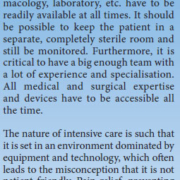Quo Vadis, ICU?
International Hospital asked experts from Belgium, the United States of America and Switzerland on the subject of finding the most optimal solutions for intensive care in a climate of austerity where the cost of healthcare is constantly rising and budgets are shrinking. They share their views on the question: Given the cost of healthcare, shrinking budgets and other challenges, what is the the most optimal way forward for intensive care?
CRITICAL CARE SUFFERING THE MOST
Shambhu Aryal, M.D. and Enrique Diaz-Guzman, M.D., Division of Pulmonary, Critical Care & Sleep Medicine, University of Kentucky, USA
We live in an era where healthcare is very exciting, but, at the same time, faces challenges it has rarely seen before. There are new discoveries and inventions every day, evidence-based medicine is at its best, patients are sicker than ever before and healthcare costs are the highest ever; yet we are faced with one of the worst economic situations, shrinking budgets, shortage of human resources and increased expectations from both the community and the government. The cost of healthcare has steadily increased over the last few decades. In the United States for example, the total per capita healthcare expenditures have increased 560% since 1980 [1]. Healthcare costs now comprise over 15% and 10% of the Gross Domestic Production of the United States and most European countries respectively [2]. Intensive care medicine, being a resource intense specialty, consumes a significant proportion of these healthcare expenditures [3]. This cost can be expected to continue to rise for several reasons: (i) an aging population; (ii) a rise in uninsured and underinsured population; (iii) use of newer and more expensive drugs and technology; and (iv) specialisation of care.
There are several other challenges to healthcare. Despite rising healthcare costs, the budget for healthcare is shrinking in most countries. There is also a concern that amid the economic recession, healthcare research funding is suffering a dramatic cut. Moreover, due to the painstaking and expensive nature of healthcare training, fewer and fewer people are opting for healthcare as a career choice; in many situations, the number of people entering the workforce is smaller than the number retiring [4].
Critical care medicine is, unfortunately, suffering the most. Despite its significant role in providing high quality healthcare and reducing healthcare costs for over half a century, Intensive Care Medicine still struggles to get the needed attention. The proportion of federally funded research dollars spent on critical care is significantly lower than the percentage of dollars spent delivering that care compared to other specialties in the USA [5]. Moreover, it is expected that there will be a huge shortage of critical care providers in the near future, but little has been done to address this issue [6].
There are several ways we could work towards addressing these challenges in healthcare in general and intensive care, in particular. One important approach is to diminish the unnecessary variation in care that exists across regions, hospitals, and providers [7]. There are several ways this could be done: better standardisation of care practice through protocols and care pathways; standardisation of the ways ICUs are organised and managed; use of evidence-based practices; avoidance of laboratory and radiological tests that have little utility in patient management; use of generic versus name brand drugs, and use of conservative transfusion practices [8]. Mechanical ventilation is associated with not only chances of increased complications, but also significant higher daily cost. Consequently, interventions that result in its reduced duration could lead to substantial reductions in total inpatient cost [9]. Similarly, since end-of-life care consumes a large proportion of ICU costs, a better focus needs to be put on judiciously reducing this cost without compromising the quality of end-of-life care through identifying terminally ill patients and instituting palliative rather than restorative care [10]. This would also mean better communication with patients and families to enable them to make more informed decisions. At the same time, measures to close the ever increasing gap of the need versus availability of ICU staff including physicians, nurses, respiratory therapists and pharmacists through a more attractive training and job environment should be sought and implemented. And finally, the importance of arranging better funding for research in the field of Critical Care cannot be over-emphasised.
References
1. Smith C, Cowan C, Heffler S, Catlin A. Health Aff (Millwood) 2006; 25: 186


